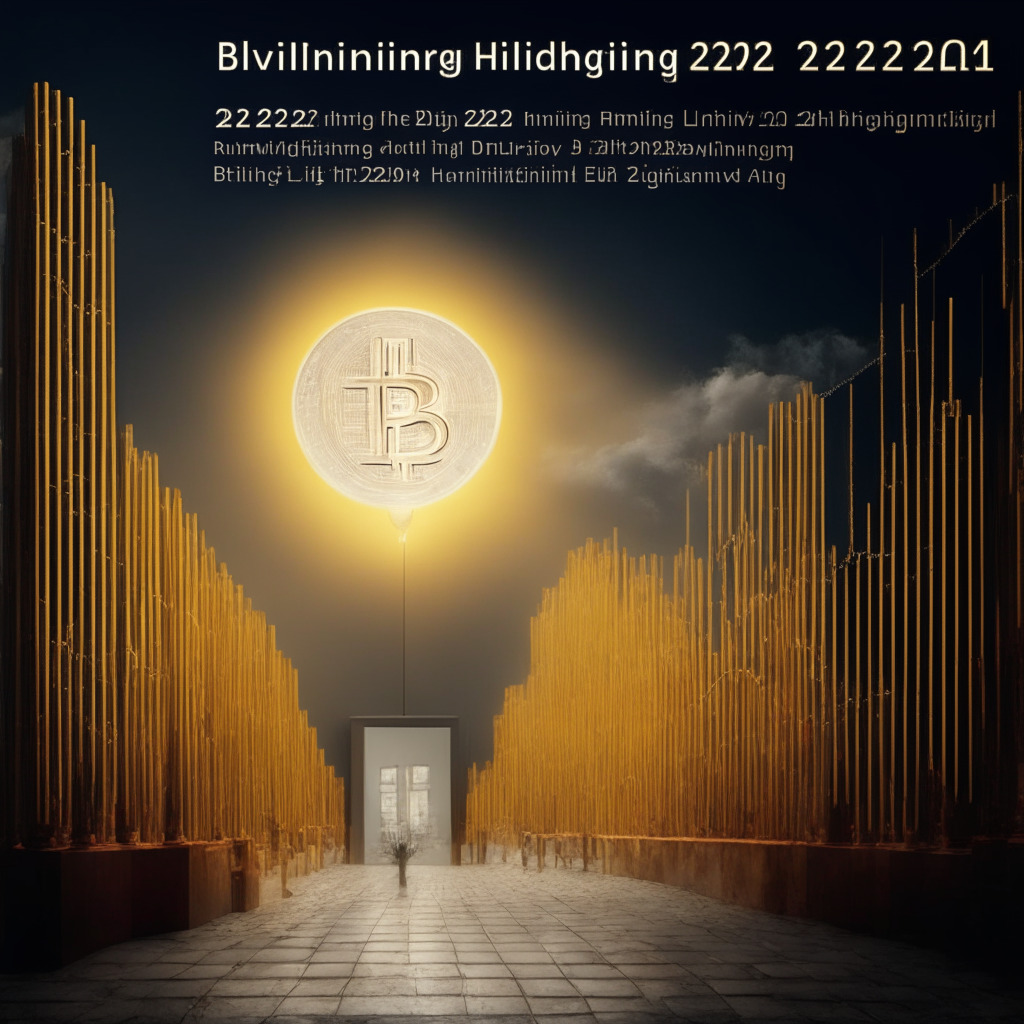“OnChainMonkey, led by Metagood CEO Danny Yang, plans to migrate their 10,000 NFTs from Ethereum to Bitcoin citing Bitcoin’s superior security. Estimated at over $1 million, the migration process highlights the significant wealth within the art/collectibles sector. Despite Ethereum’s reigning dominance in NFT transactions, this bold switch suggests possible future shifts in the crypto space.”
Search Results for: Bitcoin Ordinals
Navigating Through the Bull and Bear Markets: Uncertainties and Predictions for Bitcoin’s Future
“The rise in the U.S. dollar index (DXY) might be an obstacle on Bitcoin’s recovery path. The DXY’s upward trend has likely influenced risky assets negatively, with equities markets seeing a corrective phase. While experts predict Bitcoin consolidation within a specific range, trends in the Ethereum market currently favour the bears.”
Xverse Raises $5 Million, Aims to Fuel Bitcoin’s Mainstream Adoption: Risks and Rewards
Hong Kong-based startup Xverse, provider of the Bitcoin Web3 wallet, has raised $5 million in seed funding to facilitate the mainstream adoption of Bitcoin. The funds will drive DeFi and Bitcoin scalability solutions, sparking opportunity for the Bitcoin realm to expand.
Bitcoin Wallet Xverse Receives $5M Seed Round Boost: A Promising Step or Risky Venture?
Xverse, a Bitcoin Web3 wallet, recently received a $5 million seed round injection led by Jump Crypto to expedite development of features, notably for DeFi. The Hong Kong-based platform has been recognized for its support of Ordinal, a technique for creating NFTs on the Bitcoin blockchain, making it a captivating platform for crypto-aficionados across the globe.
Unveiling the Open Ordinals Institute: A Game-Changer for NFTs and Blockchain?
The Open Ordinals Institute, a non-profit committed to nurturing the development of nonfungible tokens (NFTs) on Bitcoin, aims to provide funding to developers of the Ordinals protocol. However, concerns arise about how centralizing efforts might affect the democratic openness that supports crypto growth. Interestingly, the Ordinals protocol’s growth could revolutionize not just NFTs on Bitcoin, but the whole crypto industry.
Bitcoin’s Validation as Global Asset: Bullish Momentum and Cautionary Notes Amid Crypto Market’s Dynamics
“Bitcoin’s current favorable standing, as per Mike Novogratz and Larry Fink’s recent remarks, has contributed to the upward momentum of BTC/USD. However, Bitcoin-based NFTs have not enjoyed similar optimism. Despite regulatory challenges, Bitcoin’s unique market standing has fostered investor trust.”
Unraveling Russia’s Bitcoin Mining Boom: Economic Incentives and Geopolitical Pressures
Despite international sanctions following Russia’s invasion of Ukraine, the country’s bitcoin mining industry is booming due to low-cost energy and a cold climate. However, businesses operating there face risks including prohibited associations with sanctioned entities and potential reputational damage. Interestingly, this doesn’t discourage foreign companies; Russia’s economic advantages and Ordinals project-enhanced blockchain activity keep improving the country’s mining conditions.
Jameson Lopp: Navigating Bitcoin’s Delicate Balance Between Scale and Decentralization
Jameson Lopp, a prominent figure in the Bitcoin community, underscores the challenges Bitcoin faces in terms of scaling potential and functionality. He compares the situation to the early internet protocol, expressing concerns over potential “ossification” – a slow-changing, unwieldy network that may limit usage to large businesses, betraying the objective of decentralisation. He also addresses the controversy over Ordinals NFTs, and the notoriety he’s faced for his crypto advocacy.
Bitcoin Resilience and Binance.US Liquidity Challenges: A Study in Crypto Market Dynamics
Bitcoin continues to show signs of positive decentralization with over one million wallets each holding at least one Bitcoin. However, Binance.US faces liquidity challenges, with a significant discount on Bitcoin and Tether (USDT) trades due to suspended fiat pipelines. The current market dynamics highlight intriguing movements in future blockchain markets and technologies.
Navigating Through Bitcoin’s $30k Intersection: The Impending Impact of Scaling Solutions
“Ethereum’s co-founder, Vitalik Buterin, underscored the necessity of scaling solutions for Bitcoin to supersede its current role as a mere payment option. Buterin advised using second-layer scaling solutions like ZK Rollup to improve Bitcoin’s sluggish transaction volume and improve its scalability.”
Ethereum’s Scalability Solutions: A Benchmark for Bitcoin or a Cause for Unique Pathways?
“Ethereum’s co-founder, Vitalik Buterin, believes that Bitcoin’s network needs to experiment with scalable solutions like zero-knowledge (ZK) rollups to grow beyond just a payment network. In contrast to Ethereum’s active experimentation with layered solutions, Bitcoin’s scalability focuses on its layer-2 solution- the Lightning Network.”
Future Bitcoin Prospects: Vitalik Buterin Advices Better Scalability Amid Controversy
Ethereum’s co-founder, Vitalik Buterin, recently debated Bitcoin’s future prospects with Eric Wall and Udi Wertheimer, well-known Bitcoin enthusiasts. The conversation centered around Bitcoin’s scalability, with Buterin suggesting a multi-pronged approach involving various layer-2 solutions and improvements to Bitcoin’s base layer. The suggested introduction of zero-knowledge rollups, a technology potentially impacting Bitcoin positively, sparked mixed reactions within the community.
Record Revenue with Bitcoin Miners: Thriving Markets of Q2 2023 Unraveled
“Bitcoin miners generated over $100 million from transaction fees in Q2 2023, a fivefold increase over last five quarters, revealing high demand for Bitcoin transactions. The surge in fee revenue is driven by Bitcoin’s recent price surge and the strategic adoption of BRC-20 token standard and Ordinals.”
Unleashing Bitcoin Potential: Luminex’s BRC-69 Standard Revolutionizing Crypto Inscription Costs
“Luminex, a launchpad platform for Bitcoin Ordinals, is introducing the BRC-69 standard promising a major reduction in inscription costs, potentially over 90%. It employs ‘Recursive Inscription’ to go beyond inscription cut-off points, enhancing both safety and efficiency of on-chain assets like NFTs.”
Bitcoin’s Monthly Loss, Mining Stocks Surge, and VC Investment: A Crypto Market Analysis
In May, Bitcoin experienced its first monthly loss since December 2022, but indicators like the futures market and VC investment reveal underlying optimism. Mining stocks showed notable gains, while VC investment surpassed $1 billion for the first time since September 2022. Increasing network activity and recent feature additions suggest the crypto market may be gradually regaining momentum.
Exploring the Future of DeFi on Bitcoin: Potential and Challenges
DeFi on Bitcoin is possible through innovative solutions, leveraging the security and liquidity benefits of the network. Although integration is a technical challenge, growing interest and developments like RSK and Stacks showcase Bitcoin’s potential role in the DeFi ecosystem.
Bridging Bitcoin and Metaverse: Exploring the Potential of Bitmap Theory
Bitmap Theory, a groundbreaking concept bridging the gap between Bitcoin and the metaverse, enables ownership claims over Bitcoin blocks and integrates them into the metaverse. This open-source standard offers new opportunities for community-driven 3D spaces, facing both potential benefits and challenges for blockchain integration and user privacy.
Bitcoin’s Struggle with $25K Resistance Amid Economic and Regulatory Uncertainty
Bitcoin’s narrow trading range has investors closely monitoring futures contract premiums and hedging costs, amid uncertainties regarding the Federal Reserve interest rate decision, US Treasury issuances, and the crypto regulatory environment. The recession risk for the U.S. economy further dampens demand for risk-on assets like Bitcoin.
Bitcoin Miners Struggle: Shrinking Revenues, High Difficulty, and Impacts on Network Hash Rate
Bitcoin miners face decreasing revenues due to a cooldown in Ordinals activity, all-time high mining difficulty, and costs. Glassnode reports miners sending more coins to exchanges as the seven-day average earnings fell from $33.9 million to $25.8 million. This could potentially lead to another period of capitulation and reduced network hash rates, impacting Bitcoin’s future.
Binance Embraces Bitcoin NFTs Amid SEC Lawsuit: Innovation or Risky Business?
Binance integrates Bitcoin NFTs into its dedicated NFT marketplace, amidst an ongoing SEC lawsuit. This significant milestone is expected to surge enthusiasm in the NFT space and broaden the uses for Binance accounts, with various popular Bitcoin NFT collections now available.
Bitcoin Downturn Amid US Debt Ceiling: Impact and Future Predictions Explained
Bitcoin experiences a downturn below $27,000 as investors assess U.S. debt ceiling deal and employment report impacts. JPMorgan research anticipates strong retail demand up to the next halving event in 2024, while Binance’s new appointment, Richard Teng, focuses on navigating regulatory challenges and bolstering the exchange’s legitimacy.
Bitcoin Halving 2024: Retail Demand Soars, Institutional Interest Wanes – Who Will Win?
JPMorgan’s recent report suggests strong retail demand for bitcoin will likely continue, driven by anticipation of the April 2024 halving event. Meanwhile, institutional demand appears to be waning due to factors such as fraud, increased volatility, and regulatory crackdowns. This divergence raises questions about bitcoin’s long-term value trajectory.
Bitcoin Memecoins Debate: Network Congestion vs. Blockchain Flexibility and Growth
The recent surge in Bitcoin-based memecoins has caused network congestion and higher gas prices, leading some developers to contemplate removing these coins from the network. However, critics argue that memecoins have played a significant role in the growth of the Bitcoin blockchain, and their removal could hinder its flexibility as a digital asset platform. Open dialogue is needed to weigh the benefits and drawbacks while ensuring long-term sustainability.
Marathon’s 77% Bitcoin Mining Surge: Proprietary Software or Untapped Capacity?
Bitcoin miner Marathon Digital Holdings experienced a 77% spike in their Bitcoin mining production in May, attributed to its proprietary software, an increased hash rate, rising transaction fees, and the growing popularity of Ordinals protocol. However, maintaining a balanced perspective and managing expectations is advised.
Predicting Bitcoin Transaction Fees: The New Crypto Crystal Ball
Rather than focusing on short-term price predictions, this article suggests examining Bitcoin transaction fees as they naturally increase with emerging use cases and growing interest in cryptocurrency. As layer-1 applications evolve, understanding and predicting fees could benefit the entire Bitcoin community, driving growth and innovation.
Litecoin’s 7% Surge: Halving Event and Bitcoin Congestion’s Impact on LTC Market
Litecoin experiences a 7% price increase in 24 hours, driven by its upcoming network halving, increased activity since April, and Bitcoin network congestion. The halving will result in a 50% reduction of block rewards, attracting strategic investors and serving as a temporary alternative during BTC congestion, although uncertainties remain.
The Shaky Future of Bitcoin: Examining Market Fluctuations, Adoption, and Crypto Utility
Bitcoin faces a 6.5% monthly drop but maintains a 68% year-to-date gain. To attract more investment, real utility and development must be demonstrated, according to John Wu, president of Ava Labs Inc. Increased network activity, including BRC20 standard Bitcoin Ordinals and NFTs, has impacted transaction fees and network congestion.
Bridging Ethereum and Bitcoin: Revolutionizing NFTs with BRC-721E Token Standard
A new blockchain token standard by Bitcoin Miladys enables Ethereum-based NFT owners to convert their tokens into Bitcoin network-based Ordinals, bridging Ethereum and Bitcoin networks. This innovative move offers compatibility with existing wallets and has contributed to significant growth in Bitcoin Ordinals inscriptions.
Soaring Blockchain Transaction Fees: Market Indicator for Bitcoin’s 2023 Boom?
Bitcoin’s rising popularity has led to increased blockchain transaction fee revenue, suggesting potential for new heights in 2023. The surge in fees reflects growing demand and adoption of cryptocurrencies for financial transactions. Analysts and investors monitor the market for Bitcoin’s upward trajectory, with recent milestones driven by factors such as the US debt ceiling deal and a stronger US dollar.
Bitcoin Mining Difficulty Nears 50T: The Impact on Miners and Blockchain Growth
Bitcoin mining difficulty is set to surpass a record 50T, driven by factors like the Bitcoin price rally and the surge in popularity of the Ordinals protocol. Increasing difficulty levels impact miner profitability but also stimulate growth within the network, with transaction fees tripling, benefiting miners’ revenue.
Bridging NFTs to Bitcoin Blockchain: BRC-721E Standard Sparks Debate on Efficiency and Potential
The launch of Bitcoin Ordinals’ BRC-721E standard enables the transfer of Ethereum’s ERC-721 NFTs to the BTC blockchain, opening new possibilities for token minting. However, critics argue the process is inefficient, making it essential to maintain a balanced viewpoint on emerging technologies.
Peter Schiff’s Unexpected NFT Collection on Bitcoin: Sincere Enthusiasm or Publicity Stunt?
Long-time Bitcoin adversary Peter Schiff announces plans to introduce a collaboratively-created NFT collection on the Bitcoin network, despite his past attempts to convince the cryptocurrency community that BTC carries no value. Schiff’s unexpected change of heart has shaken the crypto community.































